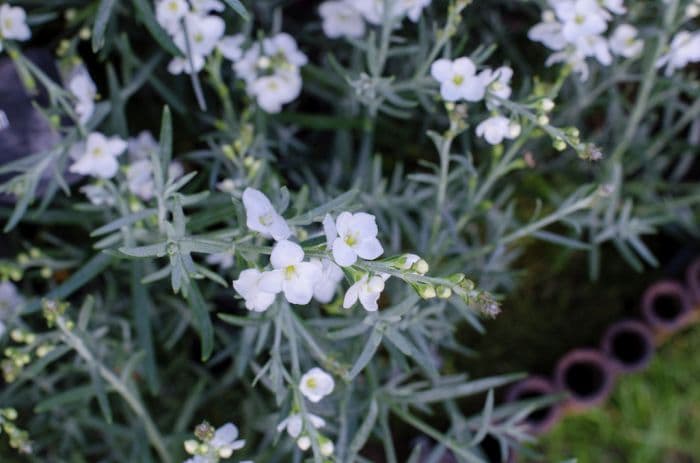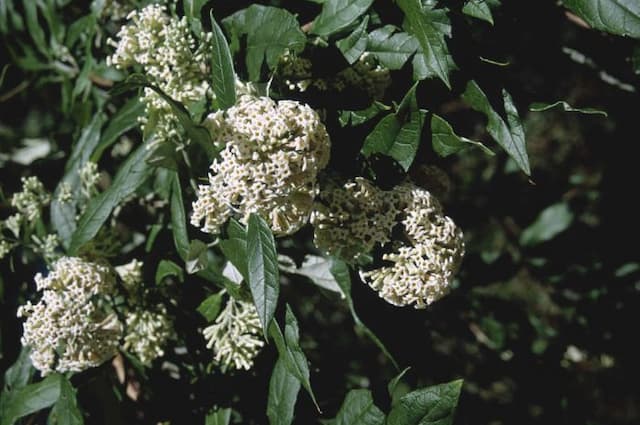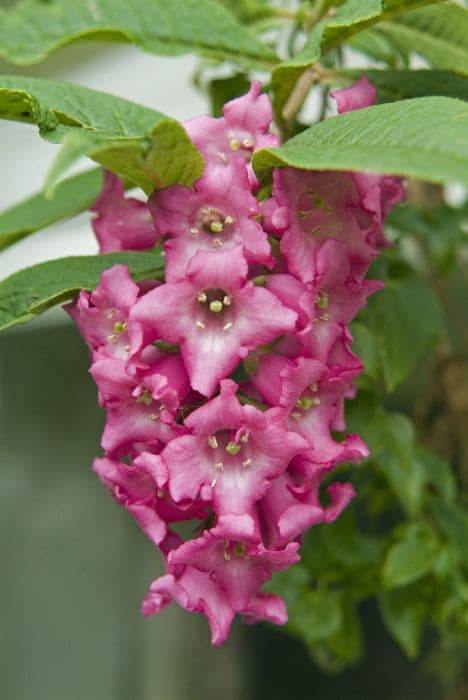Otterbush Gomphostigma virgatum

ABOUT
Gomphostigma virgatum, commonly known as river star or otter bush, is a decorative shrub that holds a distinct visual appeal. This plant usually displays an upright and slightly spreading habit, boasting slender, almost wand-like stems that add an air of delicacy to its structure. Its leaves are narrow and finely textured, presenting a silvery-green hue that seems to shimmer when caught by the light – a contrast against the darker tones commonly found in many other garden residents. The river star blooms with small, white, two-lipped flowers which cluster together to create a frothy look, reminiscent of foam atop river waves. These flowers possess a charming simplicity, emerging in abundance and attracting butterflies and other pollinators into the garden with their subtle, sweet fragrance. The foliage of the otter bush remains evergreen in warmer climates, contributing to the plant's year-round interest. The leaves and stems together create a bushy appearance, making for an attractive and versatile addition to water-wise gardens or those seeking to foster a natural, riverbank-like environment. Its aesthetic allows it to blend well with other plants yet makes it distinctive enough to stand on its own as an eye-catching specimen.
About this plant
 Names
NamesFamily
Scrophulariaceae.
Synonyms
Otter Bush, River Star.
Common names
Gomphostigma virgatum
 Toxicity
ToxicityTo humans
Gomphostigma virgatum, commonly known as Otterbush, is not widely recognized for being toxic to humans. There is limited information on its toxicity, and it is not typically listed among commonly poisonous plants. However, as with any plant, individuals may have allergic reactions or sensitivities. It is always advisable to practice caution and avoid ingesting plants not known to be safe for consumption, as individual reactions can vary. If any part of the plant is accidentally ingested and symptoms occur, medical advice should be sought.
To pets
Otterbush, also known by its scientific name Gomphostigma virgatum, is not well-known for its toxicity to pets. The literature does not extensively document cases of poisoning in pets from this plant, and it is not typically recognized as a common toxic plant to animals. However, the same precautions applicable to humans should be considered for pets. It's generally best to prevent pets from ingesting plants that are not confirmed to be safe. If a pet does ingest Otterbush and shows any signs of distress or illness, contacting a veterinarian is recommended.
 Characteristics
CharacteristicsLife cycle
Perennials
Foliage type
Evergreen
Color of leaves
Green
Flower color
White
Height
3-5 feet (0.91-1.52 meters)
Spread
3-4 feet (0.91-1.22 meters)
Plant type
Shrub
Hardiness zones
7
Native area
South Africa
Benefits
 General Benefits
General Benefits- Ornamental Value: Gomphostigma virgatum, commonly known as river star, is often used in gardens and landscapes for its attractive white flowers and elegant, shrub-like appearance.
- Wildlife Habitat: The plant provides shelter and nesting sites for various bird species and its flowers attract bees and other pollinators.
- Erosion Control: River star's root system helps stabilize riverbanks and prevent soil erosion, particularly in its native wetland habitats.
- Low Maintenance: Known for its hardiness and drought tolerance, river star requires minimal care once established, making it suitable for low-maintenance landscaping.
- Drought Resistance: As a plant adapted to dry conditions, river star can survive in areas with water scarcity, making it an environmentally sustainable choice.
- Fast Growth: Featuring a relatively quick growth rate, river star can attain its full size within a short span, providing swift landscape coverage.
- Biodiversity Support: By hosting pollinators and other wildlife, river star plays a role in supporting local biodiversity.
- Water Features: It is ideal for planting around ponds, streams, or water gardens, where it complements water features naturally.
- Seasonal Interest: River star blooms profusely in summer, providing seasonal interest in gardens with its delicate white flowers.
 Medical Properties
Medical PropertiesThis plant is not used for medical purposes.
 Air-purifying Qualities
Air-purifying QualitiesThis plant is not specifically known for air purifying qualities.
 Other Uses
Other Uses- Gomphostigma virgatum, commonly known as river star, can be used as a tool for bioengineering and stabilizing riverbanks due to its robust root system that helps prevent erosion.
- Because of its attractive white blooms and fine foliage, river star is used in floral arrangements, adding a touch of elegance and wildness to bouquets and centerpieces.
- This plant serves as a living fence or privacy screen in gardens due to its dense growth habit, providing a natural barrier that is both functional and aesthetic.
- In regions where it is native, river star is used in traditional ceremonies and festivities as a decorative plant to adorn venues or as part of cultural rituals.
- The stems of the river star are sometimes used in handcrafts, such as the creation of natural weavings or as base materials for eco-friendly art projects.
- Gomphostigma virgatum can be planted to create wildlife habitats, offering shelter and food for insects, birds, and small mammals within ecosystems that require re-establishment of local flora.
- Its quick growth and adaptability make river star an ideal candidate for use in educational projects about indigenous plants and environmental conservation.
- Gardeners may utilize the river star in xeriscaping—a landscaping method that reduces the need for irrigation—due to its drought resistance once established.
- The plant's ability to grow in both wet and dry conditions makes it a choice specimen for rain gardens, which are designed to absorb and filter runoff water.
- Its unique visual appeal is capitalized on in themed gardens, particularly those aimed at recreating the look and feel of native riverine landscapes.
Interesting Facts
 Feng Shui
Feng ShuiThe plant Gomphostigma virgatum, commonly known as River Stars, is not used in Feng Shui practice.
 Zodiac Sign Compitability
Zodiac Sign CompitabilityThe River Stars is not used in astrology practice.
 Plant Symbolism
Plant Symbolism- Purity: Gomphostigma virgatum, commonly known as river star, often symbolizes purity because of its white, delicate flowers that give it a pure and untainted look.
- Simplicity: The river star's uncomplicated appearance with its simple flower structure and lance-shaped leaves embodies the idea of simplicity and unadorned beauty.
- Peace: The white color of the river star's blooms is traditionally associated with peace and calmness, reflecting serenity in its habitat near rivers and wetlands.
- Elegance: With its slender stems and graceful flowering, the river star suggests elegance and refined taste, often used to bring a delicate touch to garden designs.
 Water
WaterOtter bush should be watered regularly to maintain a consistently moist soil environment, especially during the growing season, but without causing waterlogging. During the winter, reduce watering but do not let the soil dry out completely. Typically, watering about once a week with approximately 1 to 2 gallons of water is adequate, adjusting for rainfall and temperature conditions. Overwatering can lead to root rot, so it's important to ensure that the pot or ground has proper drainage.
 Light
LightOtter bush thrives in full sun to partial shade conditions. The ideal spot for this plant is a location where it receives at least six hours of direct sunlight each day, with some afternoon shade to protect it from intense, hot summer sun. However, it is adaptable and can still grow in less than ideal light conditions, though flowering may be reduced.
 Temperature
TemperatureOtter bush prefers temperate climates and is hardy in USDA zones 8 through 11. It can withstand temperatures as low as 20°F, but for optimal growth, maintaining an environment between 50°F and 85°F is ideal. It should be protected from frost, which can damage its foliage and stems.
 Pruning
PruningOtter bush should be pruned to maintain shape, encourage bushier growth, and remove any dead or damaged branches. The best time to prune is in late winter or early spring before new growth begins. Pruning can be done annually, but it's also acceptable to prune as needed throughout the year to keep the plant looking tidy.
 Cleaning
CleaningAs needed
 Soil
SoilRiver Bells thrive in well-draining soil with a neutral to slightly acidic pH of 6.0-7.5. A mix of loam, sand, and organic matter is ideal for optimal growth.
 Repotting
RepottingRiver Bells should be repotted every 2-3 years or when they outgrow their current container to maintain health and vigor.
 Humidity & Misting
Humidity & MistingRiver Bells prefer moderate to high humidity levels, maintaining about 50-70% humidity for optimal growth conditions.
 Suitable locations
Suitable locationsIndoor
Bright light, moderate water, and good air circulation for River Bells.
Outdoor
Plant in sun to partial shade with good drainage for River Bells.
Hardiness zone
9-11 USDA
 Life cycle
Life cycleGomphostigma virgatum, commonly known as Otterbush, typically starts its life cycle from seed, which germinates in favorable conditions of moisture and temperature. The seedlings develop a root system and a rosette of leaves at ground level. As the plant matures, it grows into a shrub with erect, branching stems and narrow leaves, reaching up to 1-2 meters in height. The Otterbush produces small, white, and fragrant flowers mainly during summer and autumn, which are followed by the formation of small fruit capsules containing seeds. After pollination, often facilitated by insects, these seeds are dispersed by wind or water, allowing the plant to colonize new areas. The Otterbush is a perennial species, able to survive for several years, with the capacity to regenerate from the base after events such as fire or pruning.
 Propogation
PropogationPropogation time
Spring-summer
Gomphostigma virgatum, commonly known as Otterbush or River Star, is often propagated through cuttings. The ideal time for propagation is during late spring to early summer when the plant is actively growing. To propagate Otterbush by cuttings, select healthy, non-flowering stems and cut them into sections of about 4 to 6 inches (10 to 15 centimeters) in length. Each cutting should have several sets of leaves. Remove the bottom leaves, leaving a few sets at the top, to prevent excessive moisture loss and focus the plant's energy on root development. Dip the cut end in rooting hormone to encourage root growth, and insert the cutting into a well-draining soil mix. Keep the soil moist but not soggy, and maintain a warm environment until roots have developed, which can usually be observed within a few weeks. Once established, the new plants can be transplanted to their final location.

![Butterfly bush [Berries and Cream]](/_next/image?url=https%3A%2F%2Fplants-admin.emdemapps.com%2Fimages%2Fplants%2F%2Fimages%2F604b650f667be.png&w=640&q=75)






